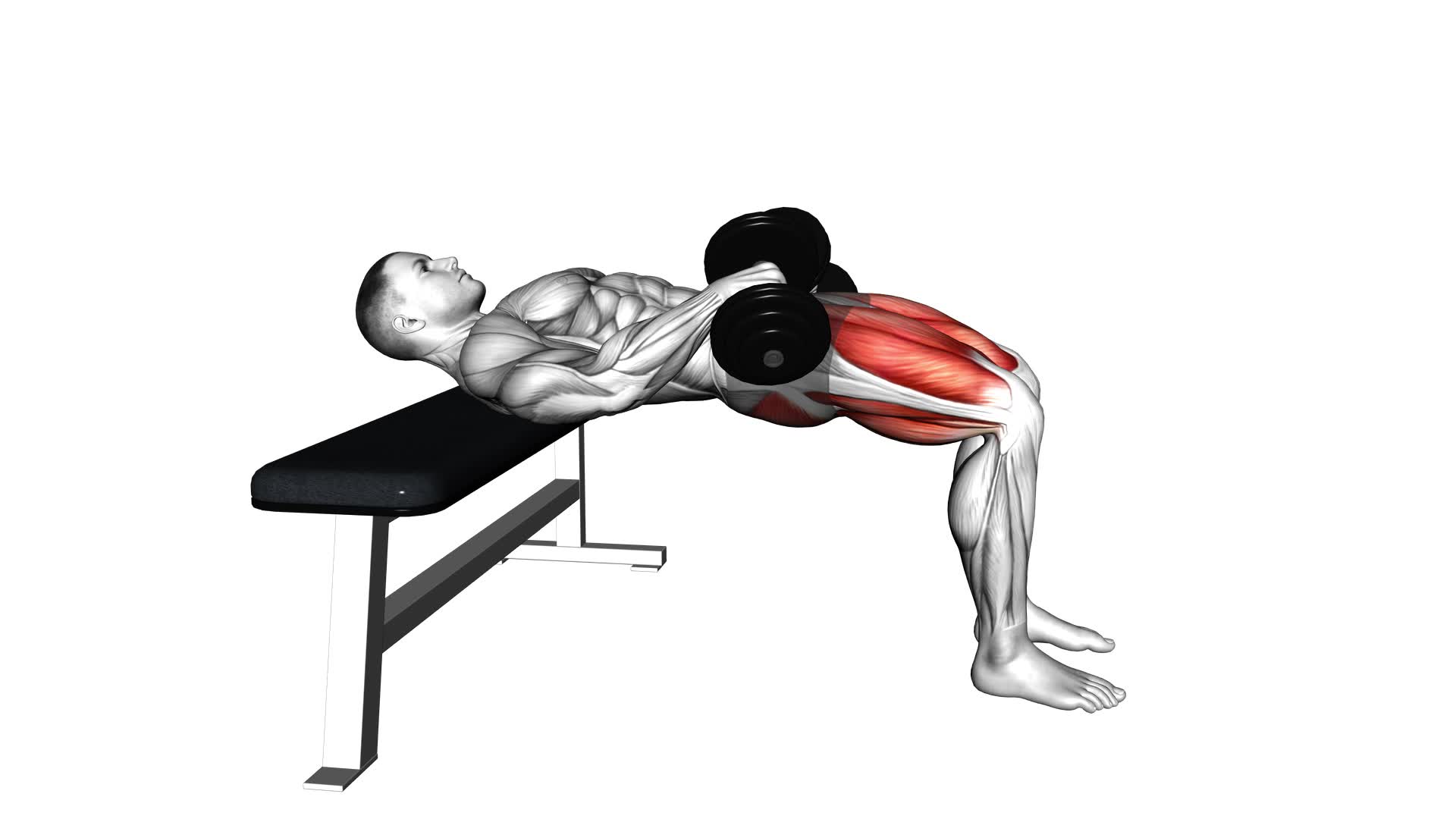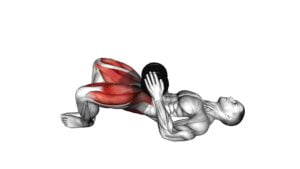Dumbbell Hip Thrust – Video Exercise Guide & Tips

Looking to strengthen your glutes and improve your overall lower body strength? The dumbbell hip thrust is the perfect exercise for you.
Watch This Exercise Video
In this video exercise guide, we will show you the proper technique, variations, and tips to maximize your results.
Whether you're a beginner or a seasoned gym-goer, this exercise is suitable for all fitness levels.
Get ready to sculpt and tone your glutes with this effective and efficient workout.
Let's dive in!
Key Takeaways
- Dumbbell hip thrusts target and strengthen the glute muscles effectively.
- Engaging the core, hamstrings, and lower back muscles is essential for a balanced workout.
- Dumbbell hip thrusts can be performed as a standalone exercise or as part of a circuit.
- The exercise is versatile and suitable for all fitness levels.
Benefits of Dumbbell Hip Thrusts
You can experience numerous benefits from incorporating dumbbell hip thrusts into your workout routine. One of the main benefits is the importance of hip thrusts for glute activation. Hip thrusts specifically target your glute muscles, helping to strengthen and tone them effectively. By incorporating dumbbells into your hip thrusts, you can increase the resistance and challenge your glutes even more.
In addition to targeting your glutes, dumbbell hip thrusts can also be a great exercise to incorporate into a full body workout routine. They engage not only your glutes but also your core, hamstrings, and lower back muscles. This makes them a versatile exercise that can contribute to an overall balanced and effective workout.
To incorporate dumbbell hip thrusts into your full body workout routine, you can perform them as a standalone exercise or as part of a circuit. If you choose to do them as a standalone exercise, aim for 2-3 sets of 10-12 repetitions. If you prefer to include them in a circuit, you can pair them with other compound exercises such as squats or deadlifts.
With the benefits and versatility that dumbbell hip thrusts offer, they're a valuable addition to any workout routine. Now, let's move on to discussing the proper technique for dumbbell hip thrusts.
Proper Technique for Dumbbell Hip Thrusts
To perform dumbbell hip thrusts with proper technique, focus on maintaining a stable position and engaging your glutes throughout the movement. This exercise targets the gluteal muscles, helping to strengthen and tone them.
To start, sit on the floor with your upper back against a bench, knees bent, and feet planted firmly on the ground. Place a dumbbell on your lap, holding it securely with both hands.
As you lift your hips off the ground, press your heels into the floor and squeeze your glutes. Keep your core engaged and your back straight throughout the movement. Avoid arching your back or letting your hips drop too low.
Common mistakes include relying too much on your lower back, not fully extending your hips, or using momentum to lift the weight. Remember to move slowly and with control, focusing on the contraction of your glutes.
Variations of Dumbbell Hip Thrusts
One variation of the dumbbell hip thrust is the single-leg dumbbell hip thrust, which further challenges your gluteal muscles. To perform this variation, start by sitting on the ground with your back against a bench and one foot flat on the floor. Hold a dumbbell on your hips and lift your other leg off the ground. Push through your heel to lift your hips up, squeezing your glutes at the top of the movement. Lower your hips back down to the starting position and repeat on the other leg.
For advanced modifications of dumbbell hip thrusts, you can increase the resistance by using heavier dumbbells or adding additional weight plates on your hips. Another option is to incorporate resistance bands into your dumbbell hip thrusts. Attach a resistance band around your knees or thighs to add extra resistance and engage your glute muscles even more.
Remember to maintain proper form throughout these variations. Keep your core engaged, your back straight, and focus on using your glute muscles to lift your hips. Start with lighter weights and gradually increase the intensity as you become more comfortable and stronger.
Incorporating these variations and advanced modifications into your dumbbell hip thrust routine can help you continue to challenge your gluteal muscles and make progress in your strength and conditioning goals.
Tips for Maximizing Results With Dumbbell Hip Thrusts
To maximize your results with dumbbell hip thrusts, it's important to focus on proper form and progressively increase the intensity of your workouts. Here are some tips that can help you get the most out of this exercise:
- Perfect your form: Make sure your shoulder blades are resting on a stable surface, and your feet are flat on the ground. Keep your core engaged and maintain a neutral spine throughout the movement.
- Gradually increase weight: Start with a weight that challenges you but allows you to maintain proper form. As you get stronger, gradually increase the weight to continue challenging your muscles and promoting growth.
- Incorporate advanced variations: Once you have mastered the basic dumbbell hip thrust, you can try more advanced variations to target different muscle groups. Some examples include single-leg hip thrusts, banded hip thrusts, or barbell hip thrusts.
- Avoid common misconceptions: Many people believe that hip thrusts are only for glute development. However, this exercise also engages your hamstrings, quadriceps, and core. So, don't neglect these muscle groups when performing hip thrusts.
Common Mistakes to Avoid With Dumbbell Hip Thrusts
To avoid common mistakes and ensure proper form when performing dumbbell hip thrusts, focus on the following tips:
- Start with a weight that you can comfortably handle and gradually increase as you get stronger. Using too much weight can lead to improper form and increase the risk of injury.
- Maintain a straight line from your knees to your shoulders. Your knees should be directly above your ankles, and your shoulders should be directly above your hips throughout the movement. Avoid arching your back or allowing your knees to cave inwards.
- Engage your glutes and core muscles throughout the exercise. Squeezing your glutes at the top of the movement and maintaining a strong core will help you achieve maximum results while also preventing strain on your lower back.
Frequently Asked Questions
How Many Sets and Reps Should I Do for Dumbbell Hip Thrusts?
To determine the number of sets and reps for dumbbell hip thrusts, consider the benefits and variations of this exercise.
Dumbbell hip thrusts target your glutes and hamstrings, promoting strength and stability in your lower body.
To maximize results, start with 3 sets of 8-12 reps, focusing on proper form and control.
As you progress, you can increase the weight and reps for added challenge.
Remember to consult a fitness professional to ensure proper technique and avoid injury.
Can I Do Dumbbell Hip Thrusts if I Have Lower Back Pain?
If you're experiencing lower back pain, it's important to consult with a healthcare professional before attempting dumbbell hip thrusts for glute activation. These exercises can put strain on your lower back and exacerbate your pain.
However, there are alternative exercises that can target your glutes without causing discomfort, such as glute bridges or single-leg glute bridges.
It's crucial to prioritize your safety and listen to your body when choosing exercises.
Are Dumbbell Hip Thrusts Suitable for Beginners?
Dumbbell hip thrusts can be suitable for beginners. They're a great exercise to target your glutes and strengthen your lower body.
By adding dumbbells, you can increase the intensity and challenge your muscles even more. To perform them properly, make sure to maintain proper form and engage your core.
There are also different variations of dumbbell hip thrusts that you can try as you progress.
Can I Use a Barbell Instead of Dumbbells for Hip Thrusts?
Yes, you can definitely use a barbell instead of dumbbells for hip thrusts. Using a barbell offers several benefits for hip thrusts.
It allows you to lift heavier weights, targeting your glutes and hamstrings more effectively.
Additionally, the barbell provides better stability and balance during the exercise.
How Long Does It Take to See Results From Dumbbell Hip Thrusts?
To see results from dumbbell hip thrusts, it's important to track your progress over time. Results can vary depending on factors like consistency, intensity, and individual body composition. Remember to focus on form and gradually increase the weight as you get stronger.
Additionally, incorporating variations and modifications can help target different muscles and prevent plateauing. Be patient and consistent with your workouts, and you'll start noticing improvements in strength and muscle tone.
Conclusion
In conclusion, dumbbell hip thrusts are a highly effective exercise for targeting and strengthening the glutes. By using proper technique and incorporating variations, you can maximize your results and see improvements in your lower body strength and stability.
Remember to avoid common mistakes and follow the tips provided to ensure you get the most out of this exercise. Incorporating dumbbell hip thrusts into your workout routine can help you achieve your fitness goals.

Author
Years ago, the spark of my life’s passion ignited in my mind the moment I stepped into the local gym for the first time. The inaugural bead of perspiration, the initial endeavor, the very first surge of endorphins, and a sense of pride that washed over me post-workout marked the beginning of my deep-seated interest in strength sports, fitness, and sports nutrition. This very curiosity blossomed rapidly into a profound fascination, propelling me to earn a Master’s degree in Physical Education from the Academy of Physical Education in Krakow, followed by a Sports Manager diploma from the Jagiellonian University. My journey of growth led me to gain more specialized qualifications, such as being a certified personal trainer with a focus on sports dietetics, a lifeguard, and an instructor for wellness and corrective gymnastics. Theoretical knowledge paired seamlessly with practical experience, reinforcing my belief that the transformation of individuals under my guidance was also a reflection of my personal growth. This belief holds true even today. Each day, I strive to push the boundaries and explore new realms. These realms gently elevate me to greater heights. The unique combination of passion for my field and the continuous quest for growth fuels my drive to break new ground.







